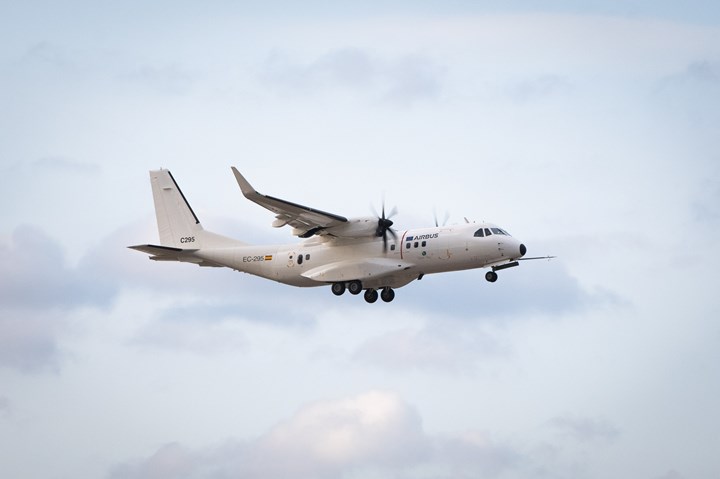Airbus C295 technology demonstrator makes maiden flight, proves novel design, manufacturing processes
C295 Flight Test Bed 2 (FTB2) tests OOA composite semi-morphing wing, flaps and flap tabs, as well as SatCom antenna for future turboprop aircraft.

Photo Credit: Airbus
The Airbus (Toulouse, France) C295 Flight Test Bed 2 (FTB2) has successfully performed its maiden flight from the Final Assembly Line in Seville, Spain. The aircraft now starts a flight campaign with the aim of testing the new semi-morphing wing — featuring a one-shot, out-of-autoclave (OOA) infused wing box demonstrated by the IIAMS project (see “Advancing the OOA infused wing box”) — the new affordable flight control system, as well as a SatCom antenna embedded within the aircraft’s fuselage.
“The first flight of the C295 FTB2 is a key milestone that represents an important step forward in the program, following the successful integration of the new aerostructures, power-on and ground tests,” says Francisco Javier Sánchez Segura, executive VP Engineering, Airbus Defence and Space. “A few years ago this program was just a dream of a more sustainable future for aviation. Today, we are at the final stage and we finally made it fly.”
Based on the Airbus C295, the Flight Test Bed 2 is an in-flight demonstrator of the European Clean Sky 2 (CS2) and the EU Horizon 2020 research and innovation program, where technologies related to CS2’s future regional multi-mission aircraft are tested (learn more in “IIAMS wing box road map to certification”).
The modifications include new materials and technologies designed to achieve noise, CO2 and NOx emissions reduction. With these technologies applied in a future regional multi-mission configuration, Airbus says up to 43% CO2 and 70% NOx reductions can be achieved in a typical search-and-rescue mission of 400 nautical miles, as well as 45% less noise during takeoff.
These modifications include a high-efficiency, semi-morphing wing, dynamic winglets and a flat panel SATCOM antenna integrated within the top of the fuselage. In addition, innovative flight controls for primary control surfaces, including ailerons, flaps and flap tabs with improved aerodynamics, are capable of adjusting in-flight and contribute to a more efficient high-lift system.
The new flight control system leverages digital control systems to optimize the aerodynamic shape of the wing in flight, while a new multifunctional flap has been completely redesigned and includes flap tabs in the trailing edge controlled by electro-mechanical actuators.
But the advantages also extend into the manufacturing process, Airbus notes, not least with the use of advanced materials and manufacturing ranging from the use of Scalmalloy and additive manufacturing (AM), to a new assembly method for the aerostructures of the wing. A one-shot assembly approach has been used for the new composite winglet and winglet tab, moving from the conventional ribs approach to a multi-spar integrated torsion box. Finally, jig-less methods have been used for the assembly of flaps and ailerons.
As a result, the C295 FTB2 is said to bring improvements to the aircraft’s operational aspects as well as introduce new improvement to the design and manufacturing process.
Related Content
-
Plant tour: Middle River Aerostructure Systems, Baltimore, Md., U.S.
The historic Martin Aircraft factory is advancing digitized automation for more sustainable production of composite aerostructures.
-
Manufacturing the MFFD thermoplastic composite fuselage
Demonstrator’s upper, lower shells and assembly prove materials and new processes for lighter, cheaper and more sustainable high-rate future aircraft.
-
Welding is not bonding
Discussion of the issues in our understanding of thermoplastic composite welded structures and certification of the latest materials and welding technologies for future airframes.
















